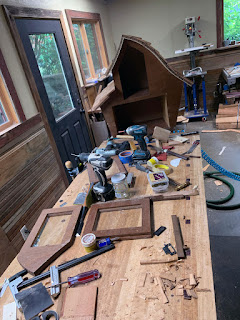After making a waiting area for G’s classroom library collection at home, the next step in finding these books a new home was to make a little free library. Our neighborhood- great evidence of why it’s a great neighborhood-does not lack for little free libraries-there is at least one more not shown on the map
But our immediate area could use one and building one is something that has been on the back burner for awhile, so after looking at a few LFL’s online and getting an idea of project size and placement from our local ones it was time to get back to the shop.A neighbor once characterized me as overbuilding, which is OK as I’d rather be safe than sorry. This tendency was particularly evident this time; I likely would have been just fine with lesser materials and finishes, but having a project on your front yard go wonky would be a drag.
The first decision was materials. I went with marine grade plywood given our very rainy climate as it was available locally and for a reasonable price, albeit 3x the cost of the regular sheet. Even then, it was recommended that it be treated with a good sealer product. This was my opportunity to work with an epoxy sealing product. I’m glad I bought the quart size. The instructions were to mix only an amount that you would be able to apply in 5-10 minutes. Being my first time, I mixed much more that that and had the mixed product spontaneously become hot, generate some very worrisome fumes and then solidify after about 15-20 minutes- pretty dramatic.
No worries, however, as I promptly took the evolving mess outside and still had plenty product to seal both exterior and interior sides.
Woodworking being a hobby, I try to learn something new with each project. In addition to the above I wanted to design a structure that stayed away from right angles and straight lines where it didn’t interfere with function.
The roof was an area that I wanted curvy in the slope and there were a number of ways to get that shape. I went with a combination of kerfing to allow the plywood to bend as needed, then used ⅛th inch flexible plywood (a find at CrossCut Lumber in Portland- a specialty product that’s worth stocking at home as it comes in handy) glued to the kerfed side and placed in molding forms to achieve the desired shape were used to make the roof.

The remainder of the build was straightforward. I was able to use the cutouts for the doors as the doors themselves- a first.
DW did the exterior painting- she’s good at that for which I’m most grateful as I don’t like painting. Thanks to the epoxy product the interior did not need further work.Making and installing the post was not something I was looking forward to as it involved working with concrete. My first concession to age was buying 60lb sacs instead of the 80 lb. The other was mixing a little at a time in a five gallon container instead of all at one in a wheelbarrow or mixer which is what I’d done in the past. It took a little longer but worked out well.But no battle plan survives first encounter with the enemy and when placing the LFL on its stand, DW felt it was too tall; unfortunately she was (rrrrr…) right.
After painstakingly putting it together and making sure it was square etc, having to modify it with a hand saw looked to be a drag of a chore, but- wasn’t too bad- a 30 minute bonus step.Here is the finished LFL, official plaque and all. We’re very happy- it’s our idea of curb appeal and it was a fun project.

And we're on the map.























